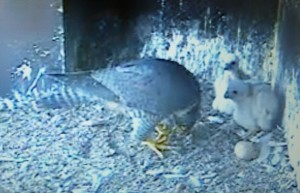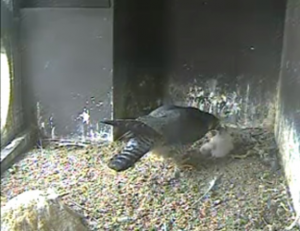May31 update. It’s been really evident this week how, although the young female is noticeably larger than the young male, her growth of darker feathers to replace the pretty white fluff of the chick phase is still a couple of days behind that of the male whom we assume hatched two days earlier too. They have both been roaming the box, sometimes into the blindspot below the camera, and trying out their developing wings vigorously, but still prefer to rest snuggled together.

May27 update. Notes from the licensed ringing on 21st May – One female, colour ring JK, weight 780 grams; one male, ring JN, 605 grams. The male had far more feather out of pin suggesting this one hatched first, 30th April, with the female hatching 2nd May. Two unhatched eggs sent to Centre for Ecology & Hydrology (Predatory Bird Monitoring Scheme) to see if CEH can confirm when the eggs failed (infertile or development).


The young are now exploring the nest box, aware of outside, developing feathers and preening, flexing wings, starting to self-feed.

May23 update. Three weeks old and the two chicks have been weighed, to check development and discover that we have one female and one male this year, and had identifying leg rings fitted, to help with scientific study of survival rates and dispersion of urban peregrines. They appear to be healthy and growing well. This despite the adults seeming to spend as much time clearing their Exeter airspace of other raptors especially buzzards, as they do hunting for prey to feed their chicks.


It’s the end of the fluffy phase and the start of the less tidy time of growing proper feathers, exploring the box, testing and strengthening those wings and getting ready for fledging, hopefully in the week starting Sunday 7 June.
May15 update. Two weeks old and being left by themselves for longer periods during the day, the 2 chicks are still all fluffy and white, but developing strong legs and talons as well as their wings and characteristic head shape. Apologies for some down-time on Wednesday from a power issue in church and the flurry of feathers during windy weather yesterday.


A week on from the hatching of 2 of the eggs, at around 6.30am on Thursday 30 April and Saturday 2 May, it’s clear that for whatever reasons the other 2 eggs are not going to hatch, and the adults should gradually lose interest in them.

The 2 little chicks are sitting up, appear to be eating and excreting well, starting to flex their little wings, and look pretty lively, so let’s hope that with just the two of them to feed, their growth and development carries on over the next 5 weeks, and the outcome after fledging in June will be more successful than last year.

At other sites, the Nottingham four seem to be doing well, Norwich hatched all 4 but one has since died, and Derby and Bath have each hatched 3 of their 4 eggs.
Calendar Notes around hatching time:-
Thurs 30 April was the 150th anniversary of the sad death of Admiral Robert FitzRoy (1805-65), a great-grandson of King Charles II (it’s in the name), and Captain of HMS Beagle for Charles Darwin’s voyage (1831-36) gathering data which helped form his theory of Evolution. FitzRoy was also founder in 1854 of the pre-cursor of the Met Office, coining the word “forecasts” for his warnings from 1861 onwards of weather hazards around the coasts of the UK.
Sat 2nd May was the Feast day of Athanasius of Alexandria, 4th century Christian teacher and formulator of “orthodox” creeds to help understand the nature of Jesus Christ and of God as Trinity.
1st May was the Feast of Saints Philip and James, Apostles, i.e. two of the first 12 disciples of Jesus. They are often known colloquially as Pip & Jim, which might well be rather more suitable names for our 2 Peregrine chicks.